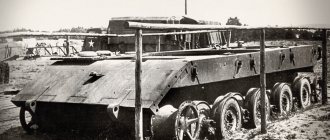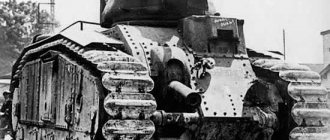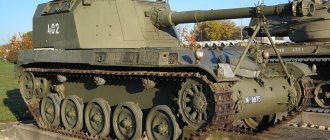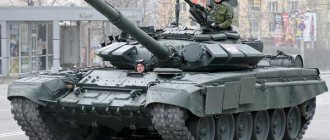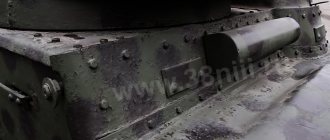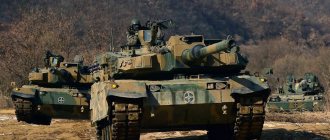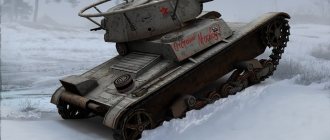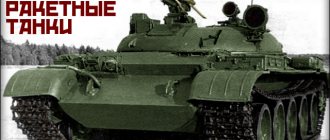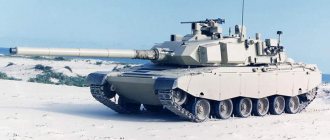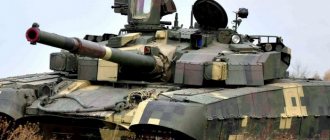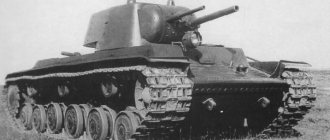FCM 2C Heavy breakthrough tank
Official designation: FCM 2C Alternate designation: Start of design: 1917 Date of construction of the first prototype: 1919 Stage of completion: 10 examples built, all lost in 1940.
The FCM 2C tank is unique in its own way. Its history began at the end of 1916, when the General Staff of the French Army demanded the creation of a heavy breakthrough tank, which was supposed to replace the unsuccessful support tanks St.Chamond M1916 and Schneider CA.1, which at the time of their appearance did not cause much enthusiasm among the military. Their driving characteristics and combat qualities in general turned out to be quite modest, which forced the French to seek help from Great Britain. After long negotiations, the British agreed to exchange 77 heavy Mk.V* tanks for the same number of light Renault FT-17s, but this deal was implemented only in 1918, and then it was necessary to find a faster solution, and on our own.
Taking into account the experience of using the “diamond-shaped” heavy tanks Mk.I and Mk.II, the French General Staff in December 1916 formulated requirements for a tank of a similar weight category and purpose. After just a month, several projects were submitted for consideration, the most promising of which seemed to be the FCM project. The estimated weight of the tank was about 38 tons, the armor was up to 30 mm, and the armament consisted of a 105 mm cannon and several machine guns. A characteristic feature of this vehicle was the placement of the main gun in a rotating turret with a circular firing sector. In the summer of 1917, the project was reworked, after which an order was issued for the construction of two experimental heavy tanks under the designation 1A, the assembly of which began in the fall of the same year. Without waiting for the prototypes to arrive for testing, FCM engineers presented a new project, which later received the 2C index. The tank turned out to be noticeably larger, and the thickness of the armor in the frontal part of the hull was increased to 45 mm.
The main armament, which consisted of a 75-mm ARX 1897 cannon, was housed in a turret with a 320-degree firing sector. Additional armament included four 8-mm Hotchkiss machine guns, one of which was mounted in the turret at the rear, two on the sides (under the main turret) and another in the front of the hull. Many problems arose when designing the chassis. According to the technical specifications, the tank had to overcome trenches and ditches 4 meters wide and at the same time not “climb out” beyond the dimensions of railway platforms. As a result, with a tank length of just over 10 meters, the ratio of width to height was 1:2.
The layout of the French tank was also difficult to call successful: the control compartment was located in the bow of the hull, followed by the fighting compartment (the turret was designed for 4 people), the engine and transmission compartment and the aft fighting compartment. The engine was located almost exactly in the center of the hull, but due to its size and additional equipment, the exhaust system and radio had to be moved upstairs, protected by an armored casing. Actually, this casing “ate” those 40 degrees. from all-round fire from the main gun. The car's transmission was complex. Two engines drove separate DC generators. Each of them supplied energy to an electric motor, which drove the corresponding tank track. If one engine failed, the power to the electric motors was switched to one generator, and then the tank weighing 70 tons could only move at walking speed. The chassis was made by analogy with the British one: it turned out to be multi-wheeled with tracks completely enveloping the body.
We can say that this time the task of “catching up and overtaking” Great Britain in the construction of heavy tanks was completely completed, which gave every reason to issue an order for 700 tanks (then reduced to 300), which were to be released for a new offensive scheduled for the spring of 1919 g. As is known, Germany capitulated in November 1919 and grandiose plans for tank breakthroughs were cancelled. The production of heavy tanks also had to be abandoned. France, devastated by the war, could no longer afford to have a large tank fleet consisting of vehicles of different types. For example, the cost of one FT-17 tank was 100,000 francs, while one 2C tank cost the treasury as much as 2,000,000 francs in 1920 prices. In addition, heavy tanks turned out to be too “gluttonous” and difficult to operate. On average, tank engines consumed 12.8 liters of fuel per 1 km of travel, so the huge 1280-liter fuel tank was completely empty after 150 km of highway travel. Over rough terrain the range was even less. A lot of money was also spent on crew training and maintenance. As a result, the active army received only 10 copies of the 2C, the assembly of which began at the end of 1918. After the end of the war, there was no hurry and the last heavy tank from this series was delivered only in 1922. According to tradition, each tank received its own name, like a warship.
The interwar period turned out to be too calm for the 2C tanks. Because in the 1920s. They were the only 2C breakthrough tanks until 1938 and were used to conduct various types of maneuvers. They continued to define the shock function, although with the advent of anti-tank artillery, the armor of heavy tanks was still considered insufficient. Of course, 20-mm and 37-mm anti-tank guns would hardly be able to penetrate the frontal armor, but from the sides and stern the tank was practically defenseless against them. The situation worsened after information was received about the introduction into production of 75-mm anti-tank guns, for which even 50-mm armor was not an obstacle. On the other hand, the gun of the 2C tank could effectively fight only light vehicles like Pz.I or Pz.II, but the limited firing angles and low mobility of the French tank reduced this advantage to a minimum. However, the existence of this “land battleship” in service with the French army for almost two decades prompted other countries to create their own “dreadnoughts on tracks.” In England, the heavy five-turret tank A1E1 “Independent” was created, in Germany – a series of two-turret medium tanks “Grosstraktor” and the heavy three-turret NbFz, and in the USSR – the heavy five-turret T-35. It is curious that until the start of the war at the Moscow Military Academy. Frunze, where command personnel for tank forces and design personnel for defense factories were trained, a two-meter model FCM 2C, carefully made of metal, was used as a visual educational aid.
In the mid-1920s. French engineers made several attempts to improve the tank's combat effectiveness. In 1923, a 155-mm short-barreled howitzer and French engines with a power of 250 hp each were experimentally installed on one of the vehicles (No. 99 “Champagne”). The mass of the tank then increased to 74 tons, which further reduced the maximum speed. As a result, the 2Сbis modification remained in a single copy, and in 1939 it was again rearmed with a 75 mm cannon.
By the beginning of 1939, all 10 copies (numbers 90-99) were preserved, some of which were not in combat-ready condition. By this time they were still in the same 511th Tank Regiment in Verdun, from where they had not left for a long time. In July, they decided to transfer the tanks to the town of Belrupt, 5 km from their original location, where the 51st Tank Battalion (51 VSS) was formed from them, consisting of three sections, commanded by Colonel Fournet. Each of them contained three tanks, and another served as a command vehicle. However, trying to overcome even such a short distance turned out to be an impossible task for few 2Cs. On the march, the old Mercedes engines literally “suffocated,” as a result of which two tanks required serious repairs.
After the start of the war, in October 1939, the battalion was redeployed to Brilly, 43 km northeast of Verdun. Here the tankers again undergo intensive training with practical shooting, and the tanks are re-equipped with Maybach engines removed from the Puteaux arsenal. They were received back in 1919 as reparations from Germany and until that moment remained unclaimed. By May 10, 1940, eight combat-ready tanks were taken to a field camp 5-6 km from Verdun and during the same month they visited Noroy ECP and Joudreville.
On the afternoon of May 12, the battalion commander received orders to load tanks at Landres station and move to the front line at the disposal of the III Army. It took several hours to prepare for the march and at about 8 pm they managed to set off, losing two cars due to technical reasons. Arriving in Landre, it turned out that there were no available locomotives. Only after urgent demands from the battalion commander and the intervention of the station chief were the locomotives allocated and at dawn on June 13, loading of the tanks onto the platforms began. Of these, two trains of three tanks each are formed. The first train leaves at 13:30, the second at 14:30.
At this time, the commander of the 513th regiment (GBC513), Colonel Saint-Sernin, in view of the rapid advance of German troops, ordered the explosion of two non-transportable tanks stuck in Menville (No. 95 “Tourane”) and Pienne (No. 92 “Picardie” "). Arriving at Gondrecourt-le-Chateau station, the battalion found itself in a difficult situation. There was no contact with the headquarters of the III Army, so there was no one to receive further instructions from. Only a few hours later, representatives of the 51st battalion managed to find the command, which gave them the order to land in the villages of Certilleux and Landaville, which are 5 and 8 km south of Neufchateau, and take up defense there. However, a few kilometers from the station the trains are subjected to aerial bombardment, but this time they manage to escape with only minor damage. The battalion headquarters that followed them, led by Colonel Fournet, fell behind their tanks because the railway track at the Certilleux station was destroyed and the road workers fled. Having gone to look for his trains with tanks, Fournet arrives in Nofchâteau, where he tries to ask the local commissar about their fate. He, obviously not in control of the situation, could not answer anything intelligibly. The situation was partly saved by the switchman, who said that both trains could have been sent along the tracks through the Is-sur-Til station, which is 22 km from Dijon. Having returned to their “original positions,” the battalion command began to patiently wait for news.
The first information arrived a day later, on May 15. It turned out that the tanks were stuck near Nofchateau. Meanwhile, army headquarters approves the route of movement through Is-sur-Tille as the safest. Between 9 and 10 o'clock in the morning, the trains manage to pass Nofshato, but the motorcyclist sent with this report fails to report this to headquarters, since he has already managed to migrate to another city. From that moment on, the commander of the 51st battalion no longer had contact with headquarters.
At 16:00 Fournet sends Captain Rolle to find out where and in what condition the trains are. Returning an hour later, Rolle reported that the tanks were blocked in the Meuse (40 km from Nofchâteau), where 5 more trains had accumulated at the station in front and behind them. Even worse, the train ahead with fuel is on fire, and the drivers and mechanics of the locomotives have escaped, having previously disabled them. By this time, German troops occupied the city of Culmont-Chalindrey, 24 km from the Meuse. Unable to unload the tanks from the platforms, Fournet makes a difficult but completely justified decision - in order to avoid the capture of the remaining 2C by the Germans, they should be destroyed. By 7 pm it was all over. The personnel and headquarters were evacuated by truck, leaving the destroyed tanks to the enemy.
However, the Germans, in almost complete condition, got tank No. 99 - it’s hard to say what prevented it from being completely disabled. Apparently, the French were in too much of a hurry and in this case limited themselves to damaging individual units. This vehicle was delivered to Berlin, where some of it was exhibited at an exhibition of captured weapons. Information about her further fate has not been preserved.
Sources: “Illustrated Guide to Tanks of the First World War.” Fedoseev S.L. Moscow. AST\Astrel. 2002 P. Touzin “Les vehicules blindes francais, 1900-1944.” EPA, 1979 Chars Francais - 1921 CHAR FCM 2C Modelik: FCM 2C
TACTICAL AND TECHNICAL CHARACTERISTICS OF THE FCM 2C HEAVY TANK, model 1921.
| COMBAT WEIGHT | 70000 kg |
| CREW, people | 12-13 |
| DIMENSIONS | |
| Length, mm | 10270 |
| Width, mm | 2950 |
| Height, mm | 4100 |
| Ground clearance, mm | ? |
| WEAPONS | one 75 mm cannon and five 7.5 mm Hotchkiss machine guns |
| AMMUNITION | 125 shells and 10,000 rounds |
| AIMING DEVICES | telescopic gun sight optical machine gun sights |
| RESERVATION | front of the hull - 45 mm side of the hull - 30 mm rear of the hull - 25 mm main turret - ? small tower - ? roof - ? bottom - 15-18 mm |
| ENGINE | two carburetor Mercedes GIIIa, 180 hp each. each (modified tanks were equipped with 250 hp Maybach engines) |
| TRANSMISSION | mechanical type |
| CHASSIS | (per side) 36 track rollers with locked spring suspension, 5 guides and 3 support rollers, front drive and rear guide wheels, large track made of steel tracks |
| SPEED | 12-15 km/h |
| HIGHWAY RANGE | 160 km |
| OBSTACLES TO OVERCOME | |
| Slope | ? |
| Wall height, m | 1,22 |
| Fording depth, m | 1,60 |
| Ditch width, m | 4,15 |
| MEANS OF COMMUNICATION | ? |
"Preamble"
In 1916-17, France created the excellent FT-17 light tank, on the basis of which many interesting vehicles were made. The tank coped well with its main task, supporting the infantry during the offensive. However, it had weak armor and weapons. A vehicle with stronger armor and powerful weapons was required. In December 1916, a committee of the French assault artillery developed a huge 38-ton colossus. It was armed with a 105 mm cannon and was covered with a 35 mm layer of armor. However, this car had terrible cross-country ability. Soon disagreements began in the Ministry of Armaments. Some wanted to classify tanks into light, medium and heavy and produce them according to the classification, while others believed that it was necessary to focus on producing tanks of one type. And in February 1917, it became clear that the issue of heavy tanks had reached a dead end. In order to at least somewhat resolve the dispute between the military, it was decided to order three prototypes of heavy tanks from the shipbuilding company FCM. And here's what the company presented:
FCM 1A
- FCM 1A is a “light” heavy tank, weighing about 30 tons and 6.92 meters long. It was to be armed with a 75 mm cannon and powered by two 200-horsepower engines;
- FCM 1B is a 45-ton tank, 7.39 meters long, with a 75 mm cannon and two machine guns. It was to be equipped with a new 380-horsepower engine with a hydraulic transmission.
- FCM 1C is a 62-ton tank, 9.31 meters long, with a 75 mm cannon and four machine guns. It was supposed to be driven by an installation of four 110-horsepower engines with an electric transmission.
At first, the FCM 1A project seemed the most optimal. However, the first use of tanks in battle in the spring of 1917 was extremely unsuccessful, and in December 1917 the second prototype FCM 1A was presented. It weighed 41.1 tons and was armed with a shortened 105 mm cannon and two 8 mm machine guns. It was armored with 35 mm on the forehead and 25 mm on the sides. But this prototype had only 1 engine and reached speeds of up to 6 km/h.
FCM 1A made a good impression. The huge colossus crossed the ditch as it moved and broke trees. She made a strong impression with her thick armor and powerful cannon. However, the tank was very clumsy.
Some interesting information and performance characteristics
Char 2C
- The Char 2C could accommodate three people in its turret for the first time;
- The mass of the tank was 75 tons;
- The crew consisted of 13 people;
- Dimensions: Length - 10270 mm;
- Width - 3000 mm;
- Height - 4090 mm;
- Forehead - 45 mm;
- One 75 mm cannon;
- Engine power - 2x250 hp.
As you can see, dear readers, the Char 2C tank has a similar history to its “brother” T-35.
Char 2C
Despite the fact that the tank made a good impression, the French military establishment was still skeptical about heavy tanks. It was even proposed to close the project altogether and give preference to the Anglo-American Mark VIII Liberty project. But, due to patriotic considerations, they did not dare to do this. As a result, the existing Char 1C project was chosen for production. Having slightly modified it, they decided to send it for mass production in the amount of 300 pieces under the name Char 2C. However, the order was cancelled. Later, after all, they made 10 of these tanks. Each tank was named after one of the French provinces.
Char 2C Touraine
- Poitou (Poitou);
- No. 91 Provence (Provence);
- Picardie (Picardie);
- Alsace (Alsace);
- Bretagne (Brittany);
- Touraine (Touraine);
- Anjou (Anjou);
- Normandie (Normandy), from 1939 Lorraine (Lorraine or Lorraine);
- Berry (Berry);
- Champagne (Champagne);
